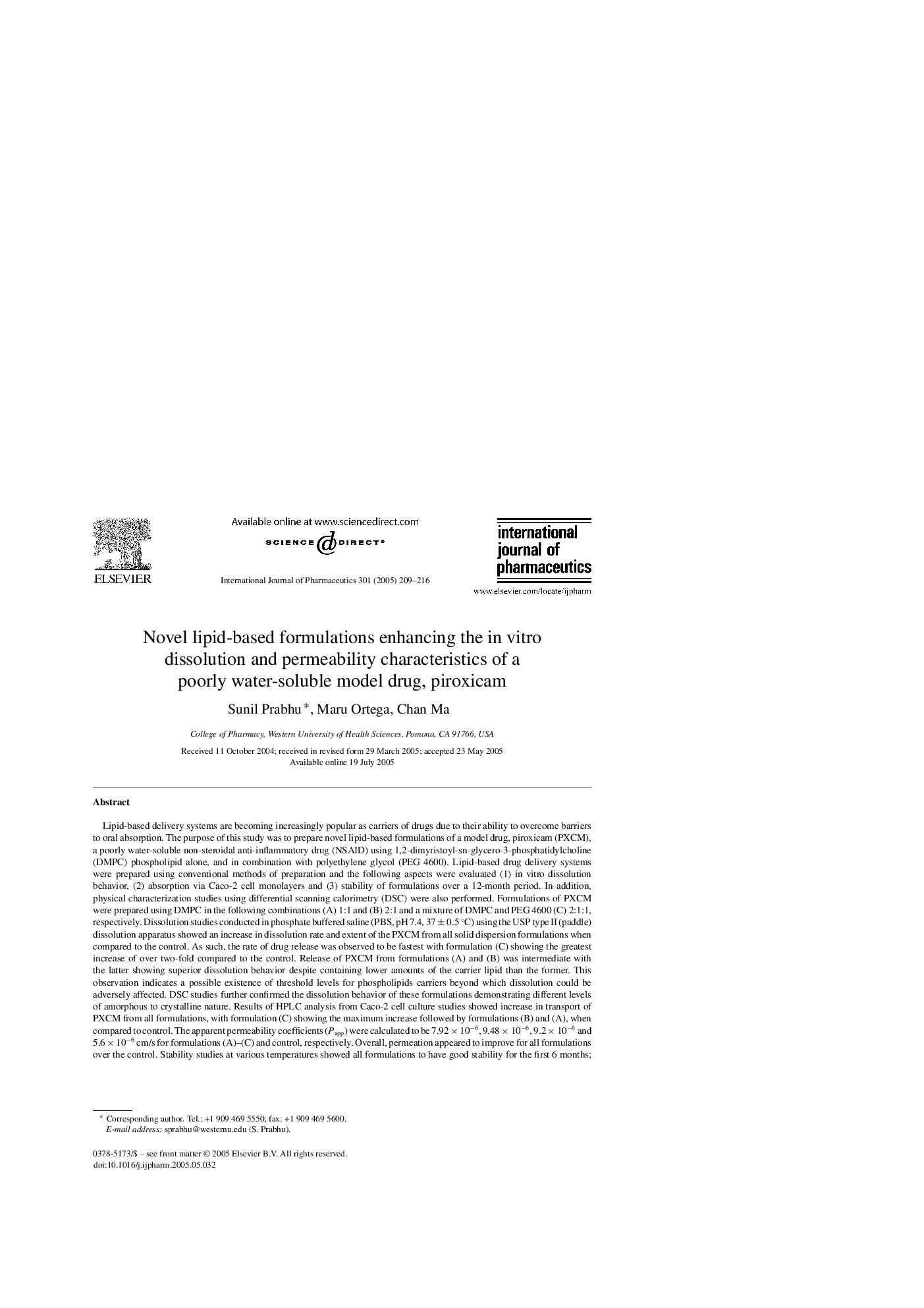| کد مقاله | کد نشریه | سال انتشار | مقاله انگلیسی | نسخه تمام متن |
|---|---|---|---|---|
| 9918659 | 1557552 | 2005 | 8 صفحه PDF | دانلود رایگان |
عنوان انگلیسی مقاله ISI
Novel lipid-based formulations enhancing the in vitro dissolution and permeability characteristics of a poorly water-soluble model drug, piroxicam
دانلود مقاله + سفارش ترجمه
دانلود مقاله ISI انگلیسی
رایگان برای ایرانیان
کلمات کلیدی
موضوعات مرتبط
علوم پزشکی و سلامت
داروسازی، سم شناسی و علوم دارویی
علوم دارویی
پیش نمایش صفحه اول مقاله

چکیده انگلیسی
Lipid-based delivery systems are becoming increasingly popular as carriers of drugs due to their ability to overcome barriers to oral absorption. The purpose of this study was to prepare novel lipid-based formulations of a model drug, piroxicam (PXCM), a poorly water-soluble non-steroidal anti-inflammatory drug (NSAID) using 1,2-dimyristoyl-sn-glycero-3-phosphatidylcholine (DMPC) phospholipid alone, and in combination with polyethylene glycol (PEG 4600). Lipid-based drug delivery systems were prepared using conventional methods of preparation and the following aspects were evaluated (1) in vitro dissolution behavior, (2) absorption via Caco-2 cell monolayers and (3) stability of formulations over a 12-month period. In addition, physical characterization studies using differential scanning calorimetry (DSC) were also performed. Formulations of PXCM were prepared using DMPC in the following combinations (A) 1:1 and (B) 2:1 and a mixture of DMPC and PEG 4600 (C) 2:1:1, respectively. Dissolution studies conducted in phosphate buffered saline (PBS, pH 7.4, 37 ± 0.5 °C) using the USP type II (paddle) dissolution apparatus showed an increase in dissolution rate and extent of the PXCM from all solid dispersion formulations when compared to the control. As such, the rate of drug release was observed to be fastest with formulation (C) showing the greatest increase of over two-fold compared to the control. Release of PXCM from formulations (A) and (B) was intermediate with the latter showing superior dissolution behavior despite containing lower amounts of the carrier lipid than the former. This observation indicates a possible existence of threshold levels for phospholipids carriers beyond which dissolution could be adversely affected. DSC studies further confirmed the dissolution behavior of these formulations demonstrating different levels of amorphous to crystalline nature. Results of HPLC analysis from Caco-2 cell culture studies showed increase in transport of PXCM from all formulations, with formulation (C) showing the maximum increase followed by formulations (B) and (A), when compared to control. The apparent permeability coefficients (Papp) were calculated to be 7.92 Ã 10â6, 9.48 Ã 10â6, 9.2 Ã 10â6 and 5.6 Ã 10â6 cm/s for formulations (A)-(C) and control, respectively. Overall, permeation appeared to improve for all formulations over the control. Stability studies at various temperatures showed all formulations to have good stability for the first 6 months; then a decline in dissolution rates was observed, especially for PEG-based lipid carrier systems, attributed to the increase in crystalline content of the solid dispersions upon storage.
ناشر
Database: Elsevier - ScienceDirect (ساینس دایرکت)
Journal: International Journal of Pharmaceutics - Volume 301, Issues 1â2, 14 September 2005, Pages 209-216
Journal: International Journal of Pharmaceutics - Volume 301, Issues 1â2, 14 September 2005, Pages 209-216
نویسندگان
Sunil Prabhu, Maru Ortega, Chan Ma,